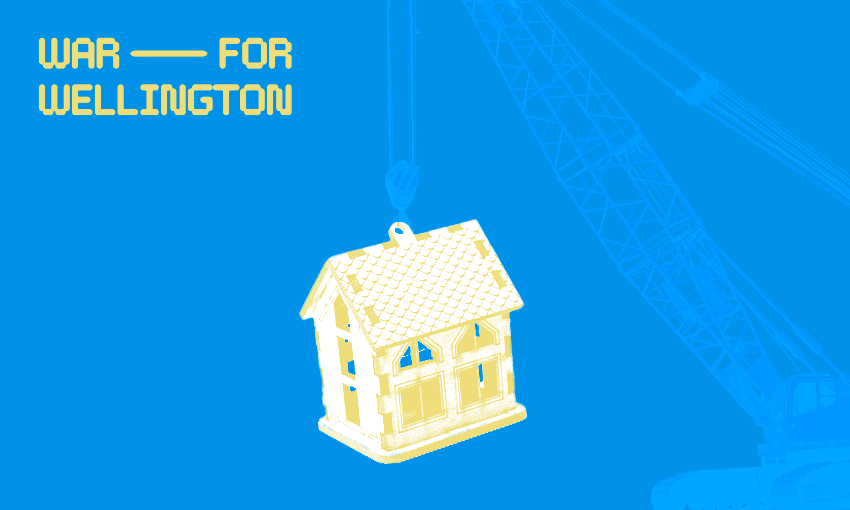We have finally found a city with a housing situation worse than our own. Please don’t take that away from us, begs Hayden Donnell.
Observing Wellington from Auckland in the early 2000s was to be filled with a poisonous, seething reservoir of envy. The capital’s cultural influence was at its peak. Every band was either The Black Seeds or The Black Seeds-adjacent. Elijah Wood, fresh from urinating in the bucket fountain, strolled down Courtenay Place and into the global premiere of Return of the King. The bucket fountain, fresh from being urinated in by Elijah Wood, was still working and filled with water and trace amounts of hobbit piss. The city was home to the country’s only functional public transport network and its sole street where you wouldn’t be run over immediately after stepping onto the carriageway. Wishbone hadn’t closed. The age of overpriced sandwiches had begun.
These days, a large proportion of the news headlines coming out of Wellington are about its landlords’ informal competition to rent out the space most similar to a medieval prison cell.
The bucket fountain is empty. Elijah Wood has moved on to Methven. The biggest lingering reminder of the city’s Lord of the Rings glory days is Peter Jackson slowly annexing Miramar in a fashion similar to the orc armies of Sauron advancing across Pelennor Fields into Gondor.
Housing – or the absence of it – is the cow pat in the rivermouth of Wellington. All its other issues are downstream of that foetid dropping, from the unviability of its overpriced sandwich market to the way it casts off people who can’t afford a place to live in rotting, unsafe lodges.
Building in Wellington is more difficult than it is almost anywhere else. The city is already short 10,222 houses, before the new District Plan kicks in. Heritage rule and character protections ban the redevelopment of prime city centre land. They stop housing in the suburbs with the best access to jobs and amenities. The city has a heritage gas tank. The Gordon Wilson Flats, built to provide low-cost social housing in the centre of town, now sit derelict and empty as a historic tribute to how the city used to build low-cost social housing in the centre of town.
Wellington’s councillors have an opportunity to turn things around on March 14 by rejecting the advice of the world’s most evidence-averse independent panel and enabling abundant housing throughout the city. As an Aucklander, I can’t advise them strongly enough to reject that chance and let Wellington die.
The last few years have been a relatively good time to be from Auckland, honestly. Since the council liberalised zoning laws with the passage of the Unitary Plan in 2016, the city has been going through a building boom that would be almost incomprehensible to the Wellington mind.
It’s transformed the fabric of the city. There are more apartments, and despite people screaming “future slum” on the community Facebook page every time one is announced, they’re actually quite nice. In fact, two just got nominated for home of the year. We have extra retirement villages to allow Boomers to experience a walkable community for the first time in their lives. Most of all, we have what’s known in urban planning parlance as a “shitload” of townhouses.
The city’s economics have changed with its shape. The New Zealand housing crisis used to be called the Auckland housing crisis. That’s no longer the case. Since 2016, Auckland rents have stagnated or dropped in real terms. Wellington’s have risen faster than the rest of the country.
After years of growth, the house price to median income ratio is now lower than it was eight years ago.
Those lines on a graph are tangible. They’re an apartment within walking distance of uni or a unit where you can grow old close to your kids. They’re a new Korean fried chicken place opening up in a once-sleepy suburb. Nothing is perfect. Nothing is fixed. But those lines mean if you look at the city in the right angle, on the right day, it can seem like things are actually getting better.
Conversely, Wellington’s lines are a young family moving to the Hutt because they can’t afford to buy a house near town. They’re unreliable public transit heading to underfilled suburbs. They’re double-digit rate rises dished to a spread out ratepayer base to pay for poo-spewing heritage pipes. They’re your city’s own councillors admitting that things used to be a bit better.
Being compared favourably with another location is a novel and thrilling experience for us. Ten years ago, whether you travelled south or north, every admission you were an Aucklander was met with a look of mock concern and words to the effect of “I’m sorry” or “get out of my pub”. That’s still the case, but now we can retort “at least I’m not from Wellington”.
Councillors, please don’t take this away from us. The truth is, it would be so easy. Wellington has all the ingredients to make a great city: a dense, walkable centre. Four thousand Mojo outlets. A fountain made of buckets. The taste and discernment to drive Wishbone out of business.
All it needs is a few more people and a housing market that doesn’t leech away 90% of their disposable income within seconds. It could make that happen by putting a few of the right colours on a map. It shouldn’t. Auckland is finally on top. It’s time to listen to the planners, architects and lawyers telling the capital it mustn’t allow more housing and keep us here.

